Thursday, 21 July 2011
the destiny: BETRAYAL
the destiny: BETRAYAL: "Adultery Musa had been working hard to make his family happy and living in pleasure. He went to the sea as early as 4.00 am to catch fish...."
Monday, 4 July 2011
the destiny: SETTLED DOWN
the destiny: SETTLED DOWN: "Getting Married During his study under the scholar called Haji Jamaluddin at Perupok, Bachok , Musa had met a local woman and fell in lov..."
Saturday, 2 July 2011
the destiny: GOODBYE SINGAPURA
the destiny: GOODBYE SINGAPURA: "Going To New Place Musa had been working much more harder for the last two months he was in Singapore . He tried to accumulate his saving ..."
Friday, 1 July 2011
the destiny: NEW INTEREST
the destiny: NEW INTEREST: "Seeking For Religious Knowledge Musa had enjoyed his life happily in Singapura , working early in the morning and going home late in the e..."
Wednesday, 22 June 2011
LOCAL FRUITS - Part 7
DURIAN 4
The durian is native to Brunei, Indonesia and Malaysia. There is some debate as to whether the durian is native to the Philippines, or was introduced. The durian is grown in other areas with a similar climate; it is strictly tropical and stops growing when mean daily temperatures drop below 22 °C (72 °F). The centre of ecological diversity for durians is the island of Borneo, where the fruit of the edible species of Durio including D. zibethinus, D. dulcis, D. graveolens, D. kutejensis, D. oxleyanus and D. testudinarum are sold in local markets. In Brunei, D. zibethinus is not grown because consumers prefer other species such as D. graveolens, D. kutejensis and D. oxleyanus. These species are commonly distributed in Brunei, and together with other species like D. testudinarum and D. dulcis, represent rich genetic diversity.
 |
| copper durian |
Although the durian is not native to Thailand, the country is currently one of the major exporters of durians, growing 781,000 tonnes (769,000 LT; 861,000 ST) of the world's total harvest of 1,400,000 tonnes (1,380,000 LT; 1,540,000 ST) in 1999, 111,000 tonnes (109,000 LT; 122,000 ST) of which it exported to Taiwan, Hong Kong, Malaysia, Singapore and Canada. Malaysia and Indonesia follow, both producing about 265,000 tonnes (261,000 LT; 292,000 ST) each. Of this, Malaysia exported 35,000 tonnes (34,000 LT; 39,000 ST) in 1999. Chantaburi in Thailand each year holds the World Durian Festival in early May. This single province is responsible for half of the durian production of Thailand. In the Philippines, the centre of durian production is the Davao Region. The Kadayawan Festival is an annual celebration featuring the durian in Davao City.
 |
| durian flesh packed for sale with an exposed seed |
The durian is a seasonal fruit, unlike some other non-seasonal tropical fruits such as the papaya, which are available throughout the year. In Peninsular Malaysia and Singapore, the season for durians is typically from June to August, which coincides with that of the mangosteen. Prices of durians are relatively high as compared with other fruits. For example, in Singapore, the strong demand for high quality cultivars such as the D24, Sultan, and Mao Shan Wang has resulted in typical retail prices of between S$8 to S$15 (US$5 to US$10) per kilogram of whole fruit. With an average weight of about 1.5 kilograms (3.3 lb), a durian fruit would therefore cost about S$12 to S$22 (US$8 to US$15). The edible portion of the fruit, known as the aril and usually referred to as the "flesh" or "pulp", only accounts for about 15-30% of the mass of the entire fruit. Many consumers in Singapore are nevertheless quite willing to spend up to around S$75 (US$50) in a single purchase of about half a dozen of the favoured fruit to be shared by family members. In-season durians can be found in mainstream Japanese supermarkets while, in the West, they are sold mainly by Asian markets.
LOCAL FRUITS - Part 6
DURIAN 3
 Most cultivars have a common name and a code number starting with "D". For example, some popular clones are Kop (D99), Chanee (D123), Berserah or Green Durian or Tuan Mek Hijau (D145), Kan Yao (D158), Mon Thong (D159), Kradum Thong (Thai), and with no common name, D24 and D169. Each cultivar has a distinct taste and odour. More than 200 cultivars of D. zibethinus exist in Thailand. Mon Thong is the most commercially sought after for its thick, full-bodied creamy and mild sweet tasting flesh with relatively moderate smell emitted and smaller seeds while Chanee is the best in terms of its resistance to infection by Phytophthora palmivora.
Most cultivars have a common name and a code number starting with "D". For example, some popular clones are Kop (D99), Chanee (D123), Berserah or Green Durian or Tuan Mek Hijau (D145), Kan Yao (D158), Mon Thong (D159), Kradum Thong (Thai), and with no common name, D24 and D169. Each cultivar has a distinct taste and odour. More than 200 cultivars of D. zibethinus exist in Thailand. Mon Thong is the most commercially sought after for its thick, full-bodied creamy and mild sweet tasting flesh with relatively moderate smell emitted and smaller seeds while Chanee is the best in terms of its resistance to infection by Phytophthora palmivora.
The name durian comes from the Malay word duri (thorn) together with the suffix -an (for building a noun in Malay). D. zibethinus is the only species commercially cultivated on a large scale and available outside of its native region. Since this species is open-pollinated, it shows considerable diversity in fruit colour and odour, size of flesh and seed, and tree phenology. In the species name, zibethinus refers to the Indian civet, Viverra zibetha. There is disagreement regarding whether this name, bestowed by Linnaeus, refers to civets being so fond of the durian that the fruit was used as bait to entrap them, or to the durian smelling like the civet.
| durian flowers |
Durian flowers are large and feathery with copious nectar, and give off a heavy, sour and buttery odour. These features are typical of flowers pollinated by certain species of bats that eat nectar and pollen.According to research conducted in Malaysia in the 1970s, durians were pollinated almost exclusively by cave fruit bats (Eonycteris spelaea). However, a 1996 study indicated two species, D. grandiflorus and D. oblongus, were pollinated by spiderhunters (Nectariniidae) and another species, D. kutejensis, was pollinated by giant honey bees and birds as well as bats.
Over the centuries, numerous durian cultivars propagated by vegetative clones have arisen in southeast Asia. They used to be grown with mixed results from seeds of trees bearing superior quality fruit, but are now propagated by layering, marcotting, or more commonly, by grafting, including bud, veneer, wedge, whip or U-grafting onto seedlings of randomly selected rootstocks. Different cultivars can be distinguished to some extent by variations in the fruit shape, such as the shape of the spines. Durian consumers express preferences for specific cultivars, which fetch higher prices in the market.
Among all the cultivars in Thailand, five are currently in large-scale commercial cultivation: Chanee, Mon Thong, Kan Yao, Ruang, and Kradum. There are more than 100 registered cultivars in Malaysia and many superior cultivars have been identified through competitions held at the annual Malaysian Agriculture, Horticulture and Agrotourism Show. In Vietnam, the same process has been done through competitions held by the Southern Fruit Research Institute. A recently popular variety is the Cat Mountain King.
In recent times, Songpol Somsri, a Thai government scientist, crossbred more than ninety varieties of durian to create Chantaburi No. 1, a cultivar without the characteristic odour, which is awaiting final approval from the local Ministry of Agriculture. Another hybrid, Chantaburi No. 3, develops the odour about three days after the fruit is picked, which enables an odourless transport yet satisfies consumers who prefer the pungent odour.
LOCAL FRUITS - Part 5
DURIAN 2
 The durian, native to Brunei, Indonesia and Malaysia, has been known to the Western world for about 600 years. The 19th-century British naturalist Alfred Russel Wallace famously described its flesh as "a rich custard highly flavoured with almonds". The flesh can be consumed at various stages of ripeness, and it is used to flavour a wide variety of savoury and sweet edibles in Southeast Asian cuisines. The seeds can also be eaten when cooked.
The durian, native to Brunei, Indonesia and Malaysia, has been known to the Western world for about 600 years. The 19th-century British naturalist Alfred Russel Wallace famously described its flesh as "a rich custard highly flavoured with almonds". The flesh can be consumed at various stages of ripeness, and it is used to flavour a wide variety of savoury and sweet edibles in Southeast Asian cuisines. The seeds can also be eaten when cooked.
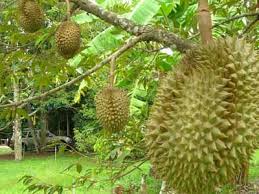 The leaves are evergreen, elliptic to oblong and 10–18 centimetres (4–7 in) long. The flowers are produced in three to thirty clusters together on large branches and directly on the trunk with each flower having a calyx (sepals) and five (rarely four or six) petals. Durian trees have one or two flowering and fruiting periods per year, though the timing varies depending on the species, cultivars, and localities. A typical durian tree can bear fruit after four or five years. The durian fruit can hang from any branch and matures roughly three months after pollination. Among the thirty known species of Durio, nine of them have been identified as producing edible fruits: D. zibethinus, D. dulcis, D. grandiflorus, D. graveolens, D. kutejensis, D. lowianus, D. macrantha, D. oxleyanus and D. testudinarum. However, there are many species for which the fruit has never been collected or properly examined, so other species with edible fruit may exist. The durian is somewhat similar in appearance to the jackfruit, an unrelated species.
The leaves are evergreen, elliptic to oblong and 10–18 centimetres (4–7 in) long. The flowers are produced in three to thirty clusters together on large branches and directly on the trunk with each flower having a calyx (sepals) and five (rarely four or six) petals. Durian trees have one or two flowering and fruiting periods per year, though the timing varies depending on the species, cultivars, and localities. A typical durian tree can bear fruit after four or five years. The durian fruit can hang from any branch and matures roughly three months after pollination. Among the thirty known species of Durio, nine of them have been identified as producing edible fruits: D. zibethinus, D. dulcis, D. grandiflorus, D. graveolens, D. kutejensis, D. lowianus, D. macrantha, D. oxleyanus and D. testudinarum. However, there are many species for which the fruit has never been collected or properly examined, so other species with edible fruit may exist. The durian is somewhat similar in appearance to the jackfruit, an unrelated species.
There are 30 recognised Durio species, at least nine of which produce edible fruit. Durio zibethinus is the only species available in the international market: other species are sold in their local regions. There are hundreds of durian cultivars; many consumers express preferences for specific cultivars, which fetch higher prices in the market.
| durian flesh and jack fruit packed together for sale |
Durian trees are large, growing to 25–50 metres (80–165 ft) in height depending on the species. In Malaysia the durian stems are processed and properly treated to become furniture woods. The demands for durian woods for furniture is high and there are very big prospects for the durian woods to be widely accepted as a good furniture wood.
LOCAL FRUITS - Part 4
Durian 1
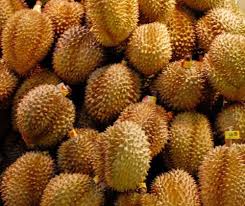 The edible flesh emits a distinctive odor, strong and penetrating even when the husk is intact. Some people regard the durian as fragrant; others find the aroma overpowering and offensive. The smell evokes reactions from deep appreciation to intense disgust, and has been described variously as almonds, rotten onions, turpentine and gym socks. The odour has led to the fruit's banishment from certain hotels and public transportation in southeast Asia.
The edible flesh emits a distinctive odor, strong and penetrating even when the husk is intact. Some people regard the durian as fragrant; others find the aroma overpowering and offensive. The smell evokes reactions from deep appreciation to intense disgust, and has been described variously as almonds, rotten onions, turpentine and gym socks. The odour has led to the fruit's banishment from certain hotels and public transportation in southeast Asia.
The durian is the fruit of several tree species belonging to the genus Durio and the Malvaceae family (although some taxonomists place Durio in a distinct family, Durionaceae). Widely known and revered in southeast Asia as the "king of fruits", the durian is distinctive for its large size, unique odour, and formidable thorn-covered husk. The fruit can grow as large as 30 centimetres (12 in) long and 15 centimetres (6 in) in diameter, and it typically weighs one to three kilograms (2 to 7 lb). Its shape ranges from oblong to round, the color of its husk green to brown, and its flesh pale yellow to red, depending on the species.
Tuesday, 21 June 2011
LOCAL FRUITS - Part 3
RAMBUTAN
Another indicator of quality is the ease of detachment of the flesh from the seed. An easily detachable flesh normally will have bits of the woody seed coating. Thus, it is a common Malay wisdom to not eat too much rambutan when one has a cough.
 Rambutan is adapted to warm tropical climates, around 22–30°, and is sensitive to temperatures below 10°C. It is grown commercially within 12–15° of the equator. The tree grows well on heights up to 500 meters (1,600 ft) above sea-level and does best in deep soil; clay loam or sandy loam rich in organic matter, and thrive on hilly terrain as they require good drainage. Rambutan is propagated by grafting, air-layering, and budding; the latter is most common as trees grown from seed often produce sour fruit. Budded trees may fruit after 2–3 years with optimum production occurring after 8–10 years. Trees grown from seed bear after 5–6 years.
Rambutan is adapted to warm tropical climates, around 22–30°, and is sensitive to temperatures below 10°C. It is grown commercially within 12–15° of the equator. The tree grows well on heights up to 500 meters (1,600 ft) above sea-level and does best in deep soil; clay loam or sandy loam rich in organic matter, and thrive on hilly terrain as they require good drainage. Rambutan is propagated by grafting, air-layering, and budding; the latter is most common as trees grown from seed often produce sour fruit. Budded trees may fruit after 2–3 years with optimum production occurring after 8–10 years. Trees grown from seed bear after 5–6 years.The aril is attached to the seed in some commercial cultivators, but "freestone" cultivators are available and in high demand. There is usually a single light brown seed which is high in certain fats and oils (primarily oleic acid and arachidic acid) valuable to industry, and used in cooking and the manufacture of soap. Rambutan roots, bark, and leaves have various uses in medicine and in the production of dyes.
 Rambutan trees bear fruit twice annually, once in late fall and early winter with a shorter season in late spring and early summer. The fragile nutritious fruit must ripen on the tree, then they are harvested over a four to seven week period. The fresh fruit are easily bruised and have a limited shelf life. An average tree may produce 5,000-6,000 or more fruit (60–70 kg or 130-155 lb per tree). Yields begin at 1.2 tonnes per hectare (0.5 tons/acre) in young orchards and may reach 20 tonnes per hectare (8 tons per acre) on mature trees. In Hawaii, 24 of 38 cultivated hectares (60 of 95 acres) were harvested producing 120 tonnes of fruit in 1997. It has been suggested that yields could be increased via improved orchard management, including pollination, and by planting high yielding compact cultivators.
Rambutan trees bear fruit twice annually, once in late fall and early winter with a shorter season in late spring and early summer. The fragile nutritious fruit must ripen on the tree, then they are harvested over a four to seven week period. The fresh fruit are easily bruised and have a limited shelf life. An average tree may produce 5,000-6,000 or more fruit (60–70 kg or 130-155 lb per tree). Yields begin at 1.2 tonnes per hectare (0.5 tons/acre) in young orchards and may reach 20 tonnes per hectare (8 tons per acre) on mature trees. In Hawaii, 24 of 38 cultivated hectares (60 of 95 acres) were harvested producing 120 tonnes of fruit in 1997. It has been suggested that yields could be increased via improved orchard management, including pollination, and by planting high yielding compact cultivators. Most commercial cultivators are hermaphroditic (producing flowers that are female with a small percentage of male flowers); cultivators that produce only functionally female flowers require the presence of male trees. Male trees are seldom found as vegetative selection has favored hermaphroditic clones that produce a high proportion of functionally female flowers and a much lower number of flowers that produce pollen. There are over 3000 greenish-white flowers in male panicles, each with 5-7 anthers and a non-functional ovary. Male flowers have yellow nectarines and 5-7 stamens. There are about 500 greenish-yellow flowers in each hermaphroditic panicle. Each flower has six anthers, usually a bi-lobed stigma, and one ovule in each of its two sections (locules). The flowers are receptive for about one day but may persist if pollinators are excluded.
Most commercial cultivators are hermaphroditic (producing flowers that are female with a small percentage of male flowers); cultivators that produce only functionally female flowers require the presence of male trees. Male trees are seldom found as vegetative selection has favored hermaphroditic clones that produce a high proportion of functionally female flowers and a much lower number of flowers that produce pollen. There are over 3000 greenish-white flowers in male panicles, each with 5-7 anthers and a non-functional ovary. Male flowers have yellow nectarines and 5-7 stamens. There are about 500 greenish-yellow flowers in each hermaphroditic panicle. Each flower has six anthers, usually a bi-lobed stigma, and one ovule in each of its two sections (locules). The flowers are receptive for about one day but may persist if pollinators are excluded.In Malaysia, rambutan flowers from March to July and again between July and November, usually in response to rain following a dry period. Flowering periods differ for other localities. Most, but not all, flowers open early in the day. Up to 100 flowers in each female panicle may be open each day during peak bloom. Initial fruit set may approach 25% but a high level of abortion contributes to a much lower level of production at harvest (1 to 3%). The fruit matures 15–18 weeks after flowering.
 Both male and female flowers are faintly sweet scented and have functional nectaries at the ovary base. Female flowers produce 2-3 times more nectar than male flowers. Nectar sugar concentration ranges between 18-47% and is similar between the flower types. Rambutan is an important nectar source for bees in Malaysia.
Both male and female flowers are faintly sweet scented and have functional nectaries at the ovary base. Female flowers produce 2-3 times more nectar than male flowers. Nectar sugar concentration ranges between 18-47% and is similar between the flower types. Rambutan is an important nectar source for bees in Malaysia.one percent of the female flowers set fruit, research revealed that no fruit is set on bagged flowers while hand pollination resulted in 13 percent fruit set. These studies further suggest that pollinators may maintain a fidelity to either male or hermaphroditic flowers (trees), thus limiting pollination and fruit set under natural conditions where crossing between male and female flowers is required.
LOCAL FRUITS - Part 2
RAMBUTAN
Rambutan is an evergreen tree growing to a height of 12–20 m and in Malaysia it is considered as a local timber woods. The leaves are alternate, 10–30 cm long, pinnate, with 3-11 leaflets, each leaflet 5–15 cm wide and 3-10 cm broad, with an entire margin. The flowers are small, 2.5–5 mm, apetalous, discoidal, and borne in erect terminal panicles 15–30 cm wide. 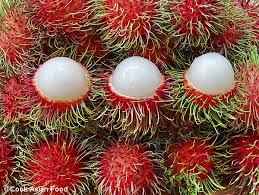
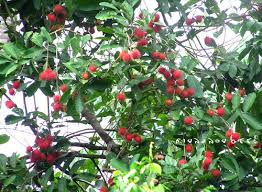 The fruit is a round to oval drupe 3–6 cm (rarely to 8 cm) tall and 3-4 cm broad, borne in a loose pendant cluster of 10-20 together. The leathery skin is reddish (rarely orange or yellow), and covered with fleshy pliable spines, hence the name rambutan, derived from the Malay word rambut which means hairs. The fruit flesh is translucent, whitish or very pale pink, with a sweet, mildly acidic flavour. The single seed is glossy brown, 1–1.3 cm, with a white basal scar. The seed is soft and crunchy. They are mildly poisonous when raw, but may be cooked and eaten.
The fruit is a round to oval drupe 3–6 cm (rarely to 8 cm) tall and 3-4 cm broad, borne in a loose pendant cluster of 10-20 together. The leathery skin is reddish (rarely orange or yellow), and covered with fleshy pliable spines, hence the name rambutan, derived from the Malay word rambut which means hairs. The fruit flesh is translucent, whitish or very pale pink, with a sweet, mildly acidic flavour. The single seed is glossy brown, 1–1.3 cm, with a white basal scar. The seed is soft and crunchy. They are mildly poisonous when raw, but may be cooked and eaten.
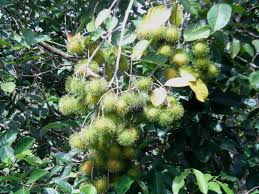 Rambutan is a popular garden fruit tree and propagated commercially in small orchards. It is one of the best known fruits of Southeast Asia and is also widely cultivated elsewhere in the tropics including Africa, the Caribbean islands, Costa Rica, India, Indonesia, the Philippines, and Sri Lanka. Thailand is the largest producer from Surat Thani Province Thailand. Rambutan production is increasing in Australia and, in 1997, was one of the top three tropical fruits produced in Hawaii. It is also produced in Ecuador where it is known as "achotillo."
Rambutan is a popular garden fruit tree and propagated commercially in small orchards. It is one of the best known fruits of Southeast Asia and is also widely cultivated elsewhere in the tropics including Africa, the Caribbean islands, Costa Rica, India, Indonesia, the Philippines, and Sri Lanka. Thailand is the largest producer from Surat Thani Province Thailand. Rambutan production is increasing in Australia and, in 1997, was one of the top three tropical fruits produced in Hawaii. It is also produced in Ecuador where it is known as "achotillo."
Rambutan trees are either male (producing only staminate flowers and, hence, produce no fruit), female (producing flowers that are only functionally female), or hermaphroditic (producing flowers that are female with a small percentage of male flowers).
The fruit are usually sold fresh, used in making jams and jellies, or canned. Evergreen rambutan trees with their abundant coloured fruit make beautiful landscape specimens.
Rambutan found in markets that is harvested as picked from their stems, is commonly ridden with insects, prone to rot, and of relatively low viability per bunch sold, especially compared to other fruits. The best quality rambutan is generally that which is harvested still attached to the branch. It is less susceptible to rot, damage, and pests, and remains fresh for a much longer time than rambutan that has been picked from the branch.
LOCAL FRUITS - Part 1

RAMBUTAN
 The rambutan (taxonomic name: Nephelium lappaceum) is a medium-sized tropical tree in the family Sapindaceae, and the fruit of this tree. It is native to Indonesia, Malaysia, The Philippines, Sri Lanka and elsewhere in Southeast Asia, although its precise natural distribution is unknown. It is closely related to several other edible tropical fruits including the Lychee, Longan, and Mamoncillo. It is believed to be native to the Malay Archipelago, from where it spread westwards to Thailand, Burma, Sri Lanka and India; eastwards to Vietnam, the Philippines and Indonesia.
The rambutan (taxonomic name: Nephelium lappaceum) is a medium-sized tropical tree in the family Sapindaceae, and the fruit of this tree. It is native to Indonesia, Malaysia, The Philippines, Sri Lanka and elsewhere in Southeast Asia, although its precise natural distribution is unknown. It is closely related to several other edible tropical fruits including the Lychee, Longan, and Mamoncillo. It is believed to be native to the Malay Archipelago, from where it spread westwards to Thailand, Burma, Sri Lanka and India; eastwards to Vietnam, the Philippines and Indonesia.  The name rambutan is from the Malay word rambutan, which literally means hairy caused by the 'hair' that covers this fruit, and is in general use in Malay and Filipino. There is a second species regularly for sale at Costa Rican markets which is known as "wild" rambutan. It is a little smaller than the usual red variety and is colored yellow. The outer skin is peeled exposing the fleshy fruit inside which is then eaten. It is sweet, sour and slightly grape like and gummy to the taste. In Costa Rican Spanish it is known as mamón chino (translated "Chinese sucker") due to the likeness of the edible part with Melicoccus bijugatus and its Asian origin.
The name rambutan is from the Malay word rambutan, which literally means hairy caused by the 'hair' that covers this fruit, and is in general use in Malay and Filipino. There is a second species regularly for sale at Costa Rican markets which is known as "wild" rambutan. It is a little smaller than the usual red variety and is colored yellow. The outer skin is peeled exposing the fleshy fruit inside which is then eaten. It is sweet, sour and slightly grape like and gummy to the taste. In Costa Rican Spanish it is known as mamón chino (translated "Chinese sucker") due to the likeness of the edible part with Melicoccus bijugatus and its Asian origin.Rambutan are non-climacteric fruit - that is, they refuse to ripen unless on the tree. Local rambutan has various type. The fruits are in red, pink and yellow color. The taste are also different, from sweet up to sour one. Rambutan fruits normally can split the flesh and the seeds easily when eaten. There are also rambutan fruits which never allow the flesh leaving the seeds. This type of rambutan is a bit smaller in size, yet sweet and delicious in taste. Some local people will swallow the flesh together with the seeds when eating it. They are very good for rambutan jams.
Subscribe to:
Posts (Atom)

